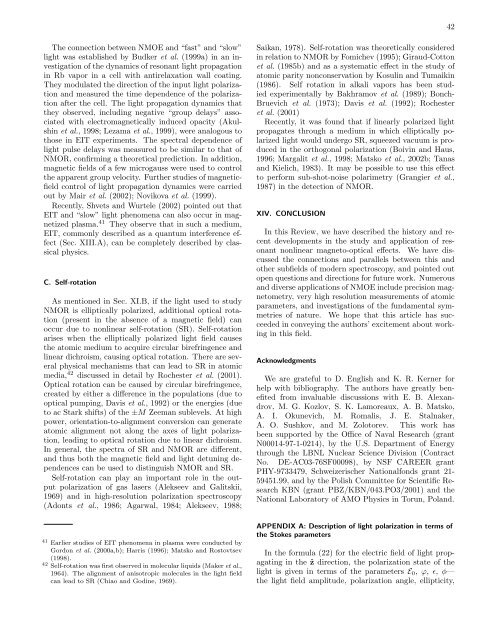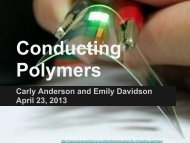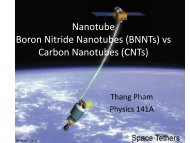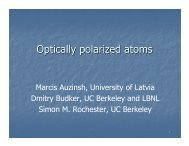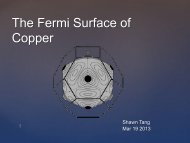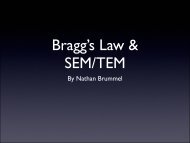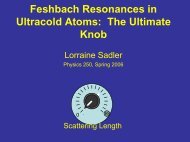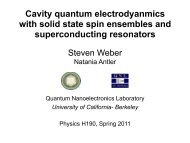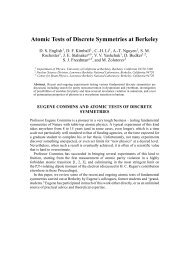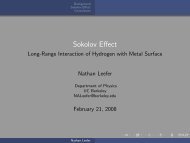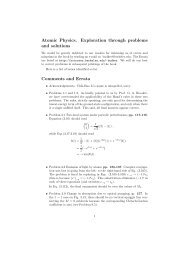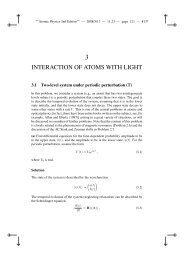Resonant nonlinear magneto-optical effects in atomsâ - The Budker ...
Resonant nonlinear magneto-optical effects in atomsâ - The Budker ...
Resonant nonlinear magneto-optical effects in atomsâ - The Budker ...
You also want an ePaper? Increase the reach of your titles
YUMPU automatically turns print PDFs into web optimized ePapers that Google loves.
42<br />
<strong>The</strong> connection between NMOE and “fast” and “slow”<br />
light was established by <strong>Budker</strong> et al. (1999a) <strong>in</strong> an <strong>in</strong>vestigation<br />
of the dynamics of resonant light propagation<br />
<strong>in</strong> Rb vapor <strong>in</strong> a cell with antirelaxation wall coat<strong>in</strong>g.<br />
<strong>The</strong>y modulated the direction of the <strong>in</strong>put light polarization<br />
and measured the time dependence of the polarization<br />
after the cell. <strong>The</strong> light propagation dynamics that<br />
they observed, <strong>in</strong>clud<strong>in</strong>g negative “group delays” associated<br />
with electromagnetically <strong>in</strong>duced opacity (Akulsh<strong>in</strong><br />
et al., 1998; Lezama et al., 1999), were analogous to<br />
those <strong>in</strong> EIT experiments. <strong>The</strong> spectral dependence of<br />
light pulse delays was measured to be similar to that of<br />
NMOR, confirm<strong>in</strong>g a theoretical prediction. In addition,<br />
magnetic fields of a few microgauss were used to control<br />
the apparent group velocity. Further studies of magneticfield<br />
control of light propagation dynamics were carried<br />
out by Mair et al. (2002); Novikova et al. (1999).<br />
Recently, Shvets and Wurtele (2002) po<strong>in</strong>ted out that<br />
EIT and “slow” light phenomena can also occur <strong>in</strong> magnetized<br />
plasma. 41 <strong>The</strong>y observe that <strong>in</strong> such a medium,<br />
EIT, commonly described as a quantum <strong>in</strong>terference effect<br />
(Sec. XIII.A), can be completely described by classical<br />
physics.<br />
C. Self-rotation<br />
As mentioned <strong>in</strong> Sec. XI.B, if the light used to study<br />
NMOR is elliptically polarized, additional <strong>optical</strong> rotation<br />
(present <strong>in</strong> the absence of a magnetic field) can<br />
occur due to <strong>nonl<strong>in</strong>ear</strong> self-rotation (SR). Self-rotation<br />
arises when the elliptically polarized light field causes<br />
the atomic medium to acquire circular birefr<strong>in</strong>gence and<br />
l<strong>in</strong>ear dichroism, caus<strong>in</strong>g <strong>optical</strong> rotation. <strong>The</strong>re are several<br />
physical mechanisms that can lead to SR <strong>in</strong> atomic<br />
media, 42 discussed <strong>in</strong> detail by Rochester et al. (2001).<br />
Optical rotation can be caused by circular birefr<strong>in</strong>gence,<br />
created by either a difference <strong>in</strong> the populations (due to<br />
<strong>optical</strong> pump<strong>in</strong>g, Davis et al., 1992) or the energies (due<br />
to ac Stark shifts) of the ±M Zeeman sublevels. At high<br />
power, orientation-to-alignment conversion can generate<br />
atomic alignment not along the axes of light polarization,<br />
lead<strong>in</strong>g to <strong>optical</strong> rotation due to l<strong>in</strong>ear dichroism.<br />
In general, the spectra of SR and NMOR are different,<br />
and thus both the magnetic field and light detun<strong>in</strong>g dependences<br />
can be used to dist<strong>in</strong>guish NMOR and SR.<br />
Self-rotation can play an important role <strong>in</strong> the output<br />
polarization of gas lasers (Alekseev and Galitskii,<br />
1969) and <strong>in</strong> high-resolution polarization spectroscopy<br />
(Adonts et al., 1986; Agarwal, 1984; Alekseev, 1988;<br />
Saikan, 1978). Self-rotation was theoretically considered<br />
<strong>in</strong> relation to NMOR by Fomichev (1995); Giraud-Cotton<br />
et al. (1985b) and as a systematic effect <strong>in</strong> the study of<br />
atomic parity nonconservation by Kosul<strong>in</strong> and Tumaik<strong>in</strong><br />
(1986). Self rotation <strong>in</strong> alkali vapors has been studied<br />
experimentally by Bakhramov et al. (1989); Bonch-<br />
Bruevich et al. (1973); Davis et al. (1992); Rochester<br />
et al. (2001)<br />
Recently, it was found that if l<strong>in</strong>early polarized light<br />
propagates through a medium <strong>in</strong> which elliptically polarized<br />
light would undergo SR, squeezed vacuum is produced<br />
<strong>in</strong> the orthogonal polarization (Boiv<strong>in</strong> and Haus,<br />
1996; Margalit et al., 1998; Matsko et al., 2002b; Tanas<br />
and Kielich, 1983). It may be possible to use this effect<br />
to perform sub-shot-noise polarimetry (Grangier et al.,<br />
1987) <strong>in</strong> the detection of NMOR.<br />
XIV. CONCLUSION<br />
In this Review, we have described the history and recent<br />
developments <strong>in</strong> the study and application of resonant<br />
<strong>nonl<strong>in</strong>ear</strong> <strong>magneto</strong>-<strong>optical</strong> <strong>effects</strong>. We have discussed<br />
the connections and parallels between this and<br />
other subfields of modern spectroscopy, and po<strong>in</strong>ted out<br />
open questions and directions for future work. Numerous<br />
and diverse applications of NMOE <strong>in</strong>clude precision <strong>magneto</strong>metry,<br />
very high resolution measurements of atomic<br />
parameters, and <strong>in</strong>vestigations of the fundamental symmetries<br />
of nature. We hope that this article has succeeded<br />
<strong>in</strong> convey<strong>in</strong>g the authors’ excitement about work<strong>in</strong>g<br />
<strong>in</strong> this field.<br />
Acknowledgments<br />
We are grateful to D. English and K. R. Kerner for<br />
help with bibliography. <strong>The</strong> authors have greatly benefited<br />
from <strong>in</strong>valuable discussions with E. B. Alexandrov,<br />
M. G. Kozlov, S. K. Lamoreaux, A. B. Matsko,<br />
A. I. Okunevich, M. Romalis, J. E. Stalnaker,<br />
A. O. Sushkov, and M. Zolotorev. This work has<br />
been supported by the Office of Naval Research (grant<br />
N00014-97-1-0214), by the U.S. Department of Energy<br />
through the LBNL Nuclear Science Division (Contract<br />
No. DE-AC03-76SF00098), by NSF CAREER grant<br />
PHY-9733479, Schweizerischer Nationalfonds grant 21-<br />
59451.99, and by the Polish Committee for Scientific Research<br />
KBN (grant PBZ/KBN/043.PO3/2001) and the<br />
National Laboratory of AMO Physics <strong>in</strong> Torun, Poland.<br />
41 Earlier studies of EIT phenomena <strong>in</strong> plasma were conducted by<br />
Gordon et al. (2000a,b); Harris (1996); Matsko and Rostovtsev<br />
(1998).<br />
42 Self-rotation was first observed <strong>in</strong> molecular liquids (Maker et al.,<br />
1964). <strong>The</strong> alignment of anisotropic molecules <strong>in</strong> the light field<br />
can lead to SR (Chiao and God<strong>in</strong>e, 1969).<br />
APPENDIX A: Description of light polarization <strong>in</strong> terms of<br />
the Stokes parameters<br />
In the formula (22) for the electric field of light propagat<strong>in</strong>g<br />
<strong>in</strong> the ẑ direction, the polarization state of the<br />
light is given <strong>in</strong> terms of the parameters E 0 , ϕ, ɛ, φ—<br />
the light field amplitude, polarization angle, ellipticity,


